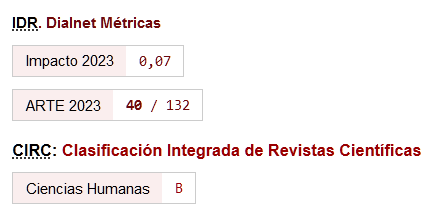La risa al servicio de lo "ridículo": El ejemplo de Velázquez
Palabras clave:
Ridículo, fisionomía, burla, risa, refranes, Velázquez, bodegones, retratos grotescosResumen
La estética de los "ridículo" supone en la pintura barroca la ruptura con los códigos normativos de la belleza clásica. Se trata de reproducir la naturaleza humana en todo lo que tiene de descompuesto y monstruoso siguiendo las teorías fisionogmóticas italianas y flamencas. Se asiste a la proliferación de personajes "que ríen y hacen reir": enanos, borrachos, rústicos, bobos y pícaros. Individuos que constituyen el alter ego de los nobles y cortesanos reflejando la tradición carnavalesca y festiva que coloca la burla en el centro de las representaciones sociales y culturales. Velásquez parece seguir en sus bodegones y retratos, una dinámica quevedesca basada en paremias y epónimos, lugares comunes del lenguaje popular enriqueciendo la imagen grotesca con un trasfondo cultural.
Descargas
Publicado
Cómo citar
Número
Sección
Licencia
Derechos de autor 2005 Antonia Morel D'Arleux

Esta obra está bajo una licencia internacional Creative Commons Atribución-NoComercial-CompartirIgual 4.0.
Los autores/as que publican en Atrio. Revista de historia del arte están de acuerdo con los siguientes términos:
- Los autores/as conservan los derechos de autor y garantizan a la revista el derecho de ser la primera publicación del trabajo al igual que licenciado bajo una licencia de Creative Commons Attribution-NonCommercial-ShareAlike 4.0 International License que permite a otros compartir el trabajo con un reconocimiento de la autoría de este y la publicación inicial en esta revista.
- El autor/a o cedente del material que se entrega para su publicación autoriza a la revista para que publique, sin obligación alguna (económica o de otra naturaleza), el contenido del referido manual tanto en formato papel, como en digital, así como en cualquier otro medio. Esta cesión de uso del material entregado comprende todos los derechos necesarios para la publicación del material en la revista. Quedan garantizados, simultáneamente, los derechos morales del autor
- El autor/a o cedente es plenamente consciente y está de acuerdo con que todos o cualesquiera de los contenidos proporcionados, formarán una obra cuyo uso se cede a la revista para su publicación total o parcial.
- El autor/a o cedente garantiza ser el titular de los derechos de Propiedad Intelectual sobre los contenidos proporcionados, es decir, sobre el propio texto e imágenes/fotografías/obras fotográficas que se incorporan en su artículo.
- El autor/a o cedente asegura y garantiza: (i) que todo el material enviado a la revista cumple con las disposiciones legales aplicables; (ii) que la utilización de cualquier material protegido por derechos de autor y derechos personales en la concepción del material se encuentra regularizada; (iii) que obtuvo las licencias de derechos, permisos y autorizaciones necesarias para la ejecución del material, inclusive los derechos de imagen, si fueran aplicables; y (iv) que el material no viola derechos de terceros, incluyendo, sin limitarse a estos, los derechos de autor y derechos de las personas.
- El autor/a o cedente, exime a la revista de toda y cualquier responsabilidad con relación a la violación de derechos de autor, comprometiéndose a emplear todos sus esfuerzos para auxiliar a la revista en la defensa de cualquier acusación, medidas extrajudiciales y/o judiciales. Asimismo, asume el abono a la revista de cualquier cantidad o indemnización que esta tenga que abonar a terceros por el incumplimiento de estas obligaciones, ya sea por decisión judicial, arbitral y/o administrativa.











